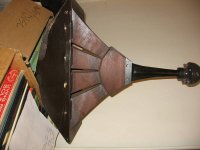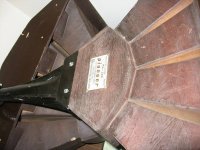To clarify a detail of the spreadsheet. The throat section is calculated to be of the overlapping style as seen in the photo below. If you want to make the more familiar Altec style with a flange, you would stop the throat at 10cm.
It may be best to build the cells first, then measure where they are all bunched together at the small end.
It may be best to build the cells first, then measure where they are all bunched together at the small end.
Attachments
I know that size determines the lower crossover, in this case about 183 Hz times two.
But can we estimate the higher crossover due to the size of a single cell?
In Petters build the cells are about 15*15 cm and he crossed it around 3000 Hz, what if a cell were 10*10 cm, how much higher would we be able to cross it?
But can we estimate the higher crossover due to the size of a single cell?
In Petters build the cells are about 15*15 cm and he crossed it around 3000 Hz, what if a cell were 10*10 cm, how much higher would we be able to cross it?
This thread just jumped again on me. I was not brave enough to paper mache the 30 cells. However, I will be getting my own CNC router which could cut some 4 - 5 cell walls in one go including the 45 degree chamfer. Then it would be "only" a matter of gluing everything together. I need to test build at least one cell when the CNC arrives.
They don't beam, that's the point of a multi-cell horn. Sound colored? I dunno, maybe above 10-11kHz, but how would you know?Yes, but at what frequency do they start to beam and sound colored?
They do, just not near as bad as basic expo, etc.:
Thank you. Gives me an understanding why sweetspoot is better with multicells.
But my question remains, the multicell mouthsize contra high crossover.
Maybe its hard to estimate?
Well yes, not horn is perfect. But in practice the multi-cell sound much smoother and more even across its pattern than many other horns. Nice even coverage.
Yepp, i also think that multicells have som nice qualitys.
I have had no problem with Altec 803, 1005 and 1505 horns playing north of 8K. I have had problems above about 8K with some horns and some drivers, but that was not a polar response problem as it occurred on axis as well.
I see no reason to low pass a multicell at 3 kHz. You should be able to get to 8 kHz easy, often higher without bad beaming. I wish that there were some good balloon measurements of multicell horns published as that would show what's going on. In practice I would not cross lower than 7 kHz.
I see no reason to low pass a multicell at 3 kHz. You should be able to get to 8 kHz easy, often higher without bad beaming. I wish that there were some good balloon measurements of multicell horns published as that would show what's going on. In practice I would not cross lower than 7 kHz.
Well yes, not horn is perfect. But in practice the multi-cell sound much smoother and more even across its pattern than many other horns. Nice even coverage.
Absolutely, just as the plots show.
I know that size determines the lower crossover, in this case about 183 Hz times two.
But can we estimate the higher crossover due to the size of a single cell?
In Petters build the cells are about 15*15 cm and he crossed it around 3000 Hz, what if a cell were 10*10 cm, how much higher would we be able to cross it?
Yes, if you know the throat, mouth, path length dims you can figure/sim its expo flare frequency, throat cut-off in hornresp.
Well, to the first approximation [pipe end correction will skew these a bit]:
~34400/[15*4] = ~573.33 Hz
~34400/[10*4] = ~860 Hz
Ln[860/573.33]/Ln[2] = 0.585 octave
3000*2^0.585 = ~4500.12 Hz
Officially they're rated at the then SMPTE motion picture 11 kHz limit, though actual sound strip was only ~9 kHz.
IIRC the 500 Hz XO cells were 800 Hz.
Anyway, RCA and Jensen made some horns with up to [32] little cells in similar/same size as Lansing's multi-cells, which had even better polar response/HF cutoff, so on the right track.
Last edited:
I have been pondering the idea of spending my retirement
Tell me about it! Between seemingly never ending health issues and a neighborhood that's changed over the decades to one where I can't play outside or even inside without significant $$$ acoustic abatement, I'm stuck at not much more than TV levels.
Last edited:
Thank you but i dont quite follow..
34400 is the speed of sound and 15 is mouthsize but why take it times 4?
Do you calculate mouthsize (15*15)*4 to get flare freqeunzy 573 Hz?
And what is Ln?
34400 is the speed of sound and 15 is mouthsize but why take it times 4?
Do you calculate mouthsize (15*15)*4 to get flare freqeunzy 573 Hz?
And what is Ln?
Yes, if you know the throat, mouth, path length dims you can figure/sim its expo flare frequency, throat cut-off in hornresp.
Well, to the first approximation [pipe end correction will skew these a bit]:
~34400/[15*4] = ~573.33 Hz
~34400/[10*4] = ~860 Hz
Ln[860/573.33]/Ln[2] = 0.585 octave
3000*2^0.585 = ~4500.12 Hz
I have been pondering the idea of spending my retirement in the pursuit of the multi-cell horn. Building, measuring, listening and trying some new ideas and techniques. But I currently don't have a good venue for playing them and that puts a damper on my enthusiasm.
Im supporting you! You could get an doctors degree in multicell horns,
how could wouldnt that be
I want to build multicells but havent got the time right now, learning as much as possible in the meantime.
Thank you but i dont quite follow..
34400 is the speed of sound and 15 is mouthsize but why take it times 4?
Do you calculate mouthsize (15*15)*4 to get flare freqeunzy 573 Hz?
And what is Ln?
Check out this link
Horn Design
In the useful equations area it states:
"For a horn radiating into full space, the horn mouth should have a circumference equal to the wavelength of the low cutoff frequency" - I assume (possibly incorrectly) that this is where the 4 comes from - to calculate the circumference.
Obviously I dont even to begin to have even an iota of the knowledge that members like GM and Pano have in this area. I know enough to only confuse myself.
I too have been interested in constructing/building multicells for some time and have been researching it for longer than I want to admit - and I had not even heard a pair - something about their appearance and aesthetic just put the crazy, obsessive bug in me. I finally got a pair of altec 1003b horns and put a pair of 288s on them - that only cemented my obsession. But in full disclosure it was not a double blinded, placebo controlled first listening session so comparisons to other horns/tweeters, etc isn't fair I guess. They were the best sounding things I had ever heard (I am not pretending to have an expansive listening history though).
Now my latest mental gymnastics have been with trying to figure out how to make a mold (or is it a cast?) of one of the 1003b cells so I can then create more of them. I have gone way down the rabbit hole on this.
Hey Tom, the 1003 is rare, I don't think I've heard or seen one. Cal Weldon has a pair of 1803 that I covet. They are enormous, Cal does love his giant speakers. 
No need to make a mold of the cell, it's a simple exponential horn that can be modeled in a program like Hornresp. I think that I've modeled the 803 and 1005 cells, so I could do the 1003 for you. It should be like my 803 with an extra column of cells.
No need to make a mold of the cell, it's a simple exponential horn that can be modeled in a program like Hornresp. I think that I've modeled the 803 and 1005 cells, so I could do the 1003 for you. It should be like my 803 with an extra column of cells.
- Home
- Loudspeakers
- Multi-Way
- The construction of a multicell horn


